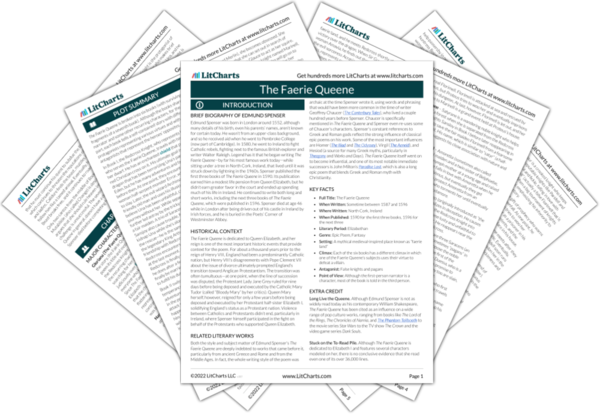Though Edmund Spenser’s The Faerie Queene draws influences from a variety of different religious traditions—including the mythology of ancient Greece and Rome—it is also an unapologetic defense of Anglican Protestantism. Many of the book’s themes, like justice or friendship, are not necessarily religious, and others like holiness or chastity play a role in many different religions. Nevertheless, a close look at the events and characters in The Faerie Queene reveals that many of the villains in the story are specifically coded to represent real-world opponents to Protestantism.
On the one hand, there are the external threats to Protestantism, often referred to in the poem as “paynim” (pagans) or Saracen. Book I, for example, has the evil trio of Sansfoy, Sansloy, and Sansjoy who oppose the Redcross Knight and try to steal away his lady Una. Book II has Pyrochles and Cymochles, the pagan knights who quarrel with the noble Sir Guyon, attempting to steal his armor while he’s injured and refusing to change their ways even after being granted second chances. These characters are often explicitly or implicitly rendered as Muslim and sometimes originally hail from Persia, recalling battles between Christianity and Islam during the Crusades as well as in Spain in the fifteenth century. These characters are often irredeemably evil, with personalities that are greedy, violent, and unrepentant.
The other big threat to Protestantism explored in The Faerie Queene is internal: Catholicism. At the time of the poem’s publication, England was in a period of fierce religious conflict, with the Protestant Queen Elizabeth having recently dethroned and beheaded the Catholic Queen Mary. This conflict is re-enacted in Book V, when the merciful Queen Mercilla makes the difficult decision to punish Duessa, a false sorceress who led men astray by disguising herself as beautiful. The tricky Duessa could reflect the contemporary Protestant belief that while Catholic practices might appear outwardly beautiful, they were inwardly false and deceptive. While Spenser’s The Fairie Queene deals with big, universal themes about virtue, its specific depictions of other religions often reveal a preference for Protestant doctrine and, in doing so, sometimes reflect anti-Catholic and other common biases of the time.
Protestantism ThemeTracker

Protestantism Quotes in The Faerie Queene
A Gentle Knight was pricking on the plaine,
Y clad in mightie armes and silver shielde,
Wherein old dints of deepe wounds did remaine,
The cruel markes of many a bloudy fielde;
[…]
But on his brest a bloudie Crosse he bore,
The dear remembrance of his dying Lord,
For whose weete sake that glorious badge he wore,
And dead as living ever him ador’d:
Upon his shield the like was also scor’d
His carriage was full comely and upright,
His countenance demure and temperate,
But yet so sterne and terrible in sight,
That cheard his friends, and did his foes amate:
He was an Elfin borne of noble state
[…]
Him als accopanyd upon the way
A comely Palmer, clad in blacke attire,
Of ripest years, and haries all hoarie gray
There the good Guyon he found slumbring fast
In senseless dream; which sight at first him sore aghast.
Beside his head there sate a faire young man,
Of woundrous beautie, and of freshest years.
After him Uther, which Pendragon hight,
Succeeding There abruptly did end
It falls me here to write of Chastity
That fairest virtue, farre above the rest;
For which what needs me fetch from Faery
Forreine ensamples, it to have exprest?
Sith it is shrined in my Soveraines brest
Now when the Beast, which by her wicked art
Late forth she sent, she backe returning spyde,
Tyde with her broken girdle, it a part
Of her rich spoyles, whom he had earst destroyd,
She weend, and woundrous gladnesse to her hart applyde.
But Britomart uprearing her from ground,
Said, Gentle Dame, reward enough I weene
For many labours more, then I have found,
This, that in safety now I have you seen,
And meane of your deliverance have beene
Of lovers sad calamities of old,
Full many piteous stories doe remaine,
But none more piteous ever was ytold,
Then that of Amorets hart-binding chaine,
And this of Florimels unworthie paine
Then was that golden belt by doome of all
Graunted to her, as to the fairest Dame.
Which being brought, about her middle small
They thought to gird, as best it her became;
But by no meanes they could it thereto frame.
And such was he, of whome I have to tell,
The Champion of true Justice Artegall.
Whom (as ye lately mote remember well)
An hard adventure, which did then befall,
Into redoubted perill forth did call.
Where being layd, the wrothfull Britonesse
Stayd not, till she came to her selfe againe,
But in revenge both of her loves distresse,
And her late vile reproach, though vaunted vaine,
And also of her wound, which sore did paine,
She with one stroke both head and helmet cleft.
When they had seene and heard her doome a rights
Against Duessa, damned by them all;
But by her tempred without griefe or gall,
Till strong constraint did her thereto enforce.
Ne may this homely verse, of many meanest,
Hope to escape his venomous despite,
More than my former writes, all were they clearest
From blamefull blot, and free from all that wite,
With which some wicked tongues did it backebite,
and bring into a mighty Peres displeasure,
That never so deserved to endite.
Therefore do you my rimes keep better measure,
And seeke to please, that now is counted wisemens threasure.











